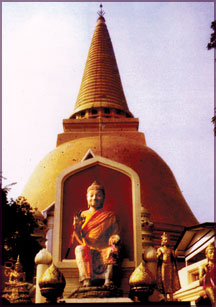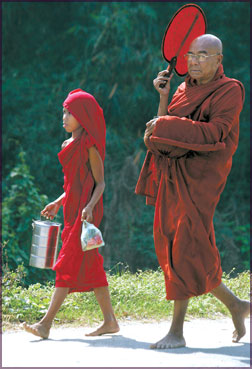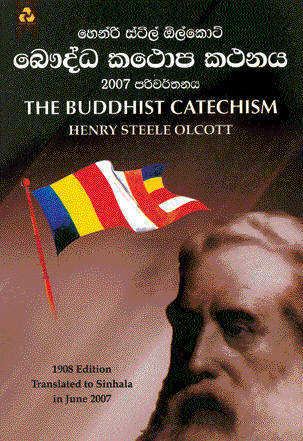Buddhist spectrum
Good governance: Buddhist perspective
Ven. Prof. Bellanwila Wimalaratana Thera
Except for those yet blindly hold into the wrong view that Buddhism
is a religion concerned about the well-being in next life, it would not
be surprise to find a very profound political philosophy in Buddhism.
The Buddha saw a very close mutual relation between secular life and
spiritual life. His belief was a settled and contended secular life
provides the congenial background necessary for gradually stepping with
spiritual life.
In providing such a congenial secular background, the Buddha firmly
believed that state had an incumbent respectively, and also an
untransferable positive role to play. This is the reason for laying down
some profound and practical political theories.
It is well-known that during the Buddha's time there were two major
systems of government. One was the monarchial system represented by such
powerful monarchism like the Magadha Kingdom, under the rulership of
King Bimbisara and Kosala Kingdom by King Pasenadi.
The other was the republican system that was represented by the
Vajjins of Vaisali. Some are of the view that the Buddha favoured the
republican system over the monarchical system.
This view is based mainly on the seven conditions of progress (Satta-aparihaniya-dhamma),
the Vajjins said to have followed and which also the Buddha advocated
for the Monks to follow. But this is not good evidence to come to such a
conclusion, for these seven conditions of progress were taught to the
Vajjins who were already practising a republican system of government.
For the Buddha to have taught them, the Vajjins, prior to the
Buddha's teaching of them, may have had problem of government. This is
why the Buddha told Ven. Ananda Thera that the Vajjins would be
invincible, as long as they follow those seven conditions.
What is clear is that the Buddha was more concerned about the way of
government than about the system adopted. The Buddha's view was that the
system of government should be selected according to the ground
conditions that prevail. This was a time when kingdoms of large
territorial extent were coming into being.
There were other collateral developments taking place in social
conditions as well as in economic and religious conditions. Perhaps, the
Buddha thought a strong central government was the best form of
government to tackle new situation that were arising.
Hence, His conception of Universal Monarch - Cakkavatti-raja.
Through His teachings on good governance the Buddha presented a
totally new political philosophy and a political culture. The then
prevalent Brahmanic political philosophy considered kingship as being of
divine origin, and hence ordained by the Almighty Supreme God, to
dispense divine justice. Beside, politics was the divinely assigned duty
to a particularly privileged class the Ksatriyas.
The Buddha discarding all these views presented the kingship or the
state as a product of social evolution that takes place due to causes
and conditions that arose in the society itself.
Due to corruption in society, the people needed a means to stop the
corrupt practices and have justice in society. The people were
interested in securing safety of life prosperity, and family etc. So
they, through common consent, selected a suitable person and, on his
agreement to undertake the responsibility of dispensing justice,
contracted with him to give him a share of their produce for his
services.
So the king or the state was the Aryan, representing not the divine
will, but the common will of the people. So, the king's or the state's
authority rested not on the will of the God above, but on the common
will of the people on earth.
While the ruling authority looked after the needs of the people, the
people, in reciprocation, remunerated the ruler.
Thus, the basic principle in Buddhist political philosophy is that
the state represents and safeguards the common will of the people.
Implementing measures to safeguard the will of the people the state was
expected to adhere to certain specific norms; and these are well brought
out in the concept of the Universal Monarch.
It should be noted that the Buddha, the spiritual leader, is the one
who sets rolling the Wheel of Dhamma (Dhamma). This represents the
spiritual righteousness, finally leading to emancipation from all
suffering (Dukkha).
The Universal Monarch is the one who sets rolling the Wheel of Dhamma
that symbolises secular righteousness, leading to eradication of
corruption, providing safety of life, prosperity, family etc., to peace,
progress and secular prosperity of the subjects, thus eradicating social
suffering.
This Wheel of the Universal Monarch, just as in the case of the
Buddha's represents dynamism. In the brahmanic political theory all
these norms were static, pre-determined, not allowing any room for
adjustments and adoptions to suit the numerous contingencies that could
arise.
The causes and conditions that could arise in the course of
governance would be so numerous, that the State has to be amenable to
the changing needs of people, the ground situations in a country where
static eternal laws cannot be operated.
This does not mean that there are no fundamental norms that embody
the wheel. There are; and these the Buddhist texts call the norms of the
Cakkavatti (Cakkavattivatta).
What are they? A fundamental norm is to provide righteous, guard,
ward and protection (Dhammikkam rakkhavaranaguttim) for all the
subjects, including the army, member of his suite, the householders,
those who living in all parts of the country, to all religious men, and
to beasts of the forests and birds of the air.
Another of his responsibilities is to eradicate all corruption in the
society. Then, he had to secure economic stability of the country and
the subjects through the proper distribution of wealth. Besides, the
ruler had to see that there is peace and harmony.
In fulfilling these norms the Universal Monarch is expected to be
kind and understanding receptive and responsive to the needs and
aspirations of the subjects. He should avoid the harsh use of punishment
and by force suppression (Adanda-asattha). In fact, the Rajja Sutta of
the Samyutta Nikaya, there is a reference to the Buddha's reflection
concerning righteous rulership.
"Whether it is possible to exercise rulership righteously, without
killing, without instigating others to kill, without confiscating,
without instigating others to confiscate, without sorrowing and without
causing to sorrow."
What is clear from this is that Buddhist political philosophy is
focused on creating a happy, prosperous, peaceful society, free of
conflict, free of any kind of wars, fears and worries, where people are
not subjected to suffering. And to do this the king or the state had to
be very sensitive to the needs of the people, receptive to good advice,
amenable in policies.
To be so, it is of paramount importance to remember that, according
to Buddhist political philosophy, the kingship or the power of governing
a country does not come as a 'parental heritage' (Pettikam dayajjam).
This ruling power had to be obtained by demonstrating the ability to
conduct effective governance. If one fails, the natural consequence is
the right to rule.
Good governance cannot be carried out by acting according to one's
own will (Samata). A good ruler should have a brilliant set of ministers
who are capable of advising him. These ministers, therefore, should be
knowledgeable people, who are quite conversant with the ways of good
governance.
A successful ruler not only seeks advice from experts while obtaining
expert advice he should temper it with the advice of experienced people,
who are now in retirement and more inclined towards spiritual good.
Thus, tempering expert advice with spiritual guidance, a ruler could
very successfully and effectively balance material program with
spiritual program.
The Buddhist political philosophy does not by means encourage
autocracy or dictatorship. It does not endorse individual's rule. Even
in the case of a monarchy, it stresses the importance of consultation
with others. While a king has to be firm, resolute and well committed,
he also has to be tender and compassionate.
This is why the relationship between the rulers and the subjects is
compared to that of parents and children. Parents have to be firm,
steadfast and strict; yet compassionate and understanding. So should the
rulers be.
Though the seven conditions of progress (Satta-aparihaniya-dhamma)
were taught by the Buddha to the Vajjins who were adopting a republican
system of government, perusal of these conditions shows that they are
applicable to any type of government committed to work for the
well-being of the country and the people.
The first condition eliminates individualism, because it advocates
meeting regularly and frequently. The second condition which emphasizes
meeting in harmony, dispersing in harmony, carry on governmental
business in harmony shows the importance of adopting a cordial attitude
among the legislators, without being hostile, confrontational and
competitive.
The third condition shows the importance of not changing the 'status
quo' merely to achieve personal ambitions.
It, however, does not advocate the maintenance of stagnation, but
cautions about adopting drastic revolutionary course for the sake of
fulfilling ulterior personal motion. Respecting elders is a condition
for stability, for elders could provide much needed advice and guidance.
Safeguarding families is another condition that greatly contributes to
the stability of a society, and hence, to the stability of the
Government.
The moral fabric of a society should be strengthened and fortified if
there is to be a balanced development of material and spiritual
condition of the people. The last two of the seven conditions of
progress provide for this.
Thus, even through short presentation of this nature, one could see
that Buddhism contains a very profound political philosophy that could
be very effectively and profitably made use of for the good and the
well-being of the people.
Great Pagoda in Thailand world's tallest stupa
Prof. Tissa Kariyawasam
Historians are of the view that Buddhism reached Siam (renamed
Thailand after 1949) even before ancestors of the present day Siamese
migrated to the country. After embracing Buddhism, King Asoka sent
Buddhist missionaries to various parts of the East.
This is clearly evident in Sri Lanka's Great Chronicle Mahavamsa
written during the 5th century AD, by a Buddhist monk named Mahanama.
According to this report Mahinda, the son of the Emperor Asoka was sent
to Lankadeepa whilst Sona and Uttara Theras visited Suvannabhumi or
present day Thailand where they were confronted with a flesh-eating
she-demon who is said to have devoured the newly begotten Royalty.
|

The Great Pagoda of the First City, Nakhon Pathom |
From that point onwards Buddhism was elevated to the position of the
religion of the royal palace and the people of the country accepted
Buddhism as their religion. The capital city of Suvannabhumi is now
known as Nakhon Pathom. Nakhon is derived from Nagara in Sanskrit and
Pali meaning 'city'; Pathom comes from Pathamam in Pali meaning the
first; thus giving Nakhon Pathom the meaning First City or the First
Capital of Thailand.
Phra Pathom Chedi is the highest stupa in the world and is located in
Nakhon Pathom, Thailand. Phra Pathom Chedi means the Great First Stupa.
Cetiya in Pali and Caitya in Sanskrit are established in Thai as Chedi.
Scholars of the calibre of M. C. Subhadidas Diskul, have engaged in
research on the history of the stupa and have determined the date of
erection as being approximately in the period of Suvannabhumi i.e. from
193 BC to 457 AD.
The enlargement of the edifice in size was carried out during the
Dvaravati period from 5th century to 11th century AD.
After a period of decadence of more than 800 years in 1853, King
Mongkut or Rama IV, whilst residing in the temple as a Bhikku decided to
restore the stupa when he ascended the throne. Unfortunately he could
not complete the structure before his demise and the present chedi was
completed by King Rama VI.
After climbing barely a 100 steps we reach the Phra Narachet where
the white stone Buddha image is located. This belongs to the Dvaravati
period and had been transported to Phra Narachet from another temple in
piecemeal.
|

A Buddhist monk with a novice walking for alms and offerings
in Yangon, Myanmar. AFP |
The seated Buddha is robed with one shoulder exposed. His feet rest
on a lotus blossom. The palm of the left hand turns upward and rests on
the knee in Avakasha Mudra and the right hand is in the gesture of
discussion or vitarka mudra with the thumb and index finger forming a
ring and palm turned outwards.
There are two bigger lotuses on both sides of the statue. Thai
Buddhists usually offer the lotus in the bud and do not make attempts to
blossom it out like Sri Lankan devotees.
There is a guardian deity standing on the left and a small sitting
image of the Buddha on the right.
The Great Pagoda of the First City is bell shaped (Ghanthakara) and
consists of viharas in all four directions. The height of the stupa from
the ground to the crown top is 120.45 metres, and the circumference of
the base is 235.5 metres. In the precincts of the four cardinal
directions four images of the Masters are kept.
There are peepal and banyan trees around but Thai Buddhists are
unaccustomed to paying homage to the trees unlike Sri Lanka Buddhists.
King Mongkut has ordered the planting of trees in the vicinity of the
stupa. After the completion of the shrine, the royalty accepted the
tradition of visiting the temple to offer candles and joss sticks
whenever they pass the chedi.
Around the Garbha of the stupa there are various statues depicting
the Master, the deities and episodes connected to the life of the
Master. One image represents the birth of the Prince Sithata
(Siddhartha) and two Apsaras paying homage.
Statues depict the Master's Enlightenment, His days of endurance, the
acceptance of eight handfuls of grass from a Brahmin, the offering of
milk rice by Sujata, the defeat of Mara, the delivering of the First
Sermon and the stay in the Parileyya forest where the Master was cared
for by an elephant and a monkey.
There is a colossal reclining image of the Master recast in the reign
of King Rama IV and a few Dhammacakka carvings that belong to the
Dvaravati period. A very special image and a rarity in the Buddhist
world is the image of the walking Buddha here.
The image of Mucalinda Naga with nine hoods too is located in the
area. The victory over death is depicted by a statue of Yama upon whom
the Master is seated. Yama here rides a bull and is horned in keeping
with its tantric representation.
The last is a scene of the Master at his deathbed (Parinirvana) where
the disciples are seen listening to his final discourse.
Launch of the Sinhala translation "The Buddhist Catechism"
 Bauddha Kathaopa Katahanaya the Sinhala translation of Colonel Henry
Steel Olcott's "The Buddhist Catechism" will be launched at the
Paramavidyanartha Buddhist Society Hall, Colombo 11 on February 17 at 3
p.m. Bauddha Kathaopa Katahanaya the Sinhala translation of Colonel Henry
Steel Olcott's "The Buddhist Catechism" will be launched at the
Paramavidyanartha Buddhist Society Hall, Colombo 11 on February 17 at 3
p.m.
|

